Dive Brief:
- Grubhub has announced a new three-point plan on its website aimed at providing clarity to what it calls larger issues facing the foodservice delivery industry.
- The plan includes extending the look-back period for restaurants to review all phone orders from 60 to 120 days; launching a new website to make it easier for restaurants to request direct control of any URLs registered as part of their contract with Grubhub; and facilitating roundtable events to create more direct dialogue with restaurant partners.
- Grubhub and its Seamless brand have 125,000 restaurant partners and 20 million active diners on its platform, according to the company. It is the second largest food delivery platform in the U.S. by market share.
Dive Insight:
Grubhub’s three-point plan was launched in response to what the company calls "misleading stories in the media regarding its treatment of restaurant partners." Those reports have indeed been unflattering — price-gouging restaurant partners and registering web domains that mimic local restaurant websites but link back to Grubhub are among its reported practices — and led Sen. Chuck Schumer (D-NY) to call for a federal investigation into the company in July. Gruhhub denied that it has engaged in cybersquatting.
Earlier this week on the company's earnings call and prior to the plan's announcement, CEO Matt Maloney responded to these reports by pointing to competitors' price gouging practices. This didn’t sit well with Andrew Rigie, executive director of the NYC Hospitality Alliance, who told the New York Post that Grubhub was going out of its way to anger its restaurant partners.
Perhaps this three-point plan is a start in the other direction. It does extend the phone order review period and perhaps solves the web domain issues on paper at least, and facilitating roundtable discussions is never a bad thing. However, there are cynics. Rigie criticized the company for continuing to impose a time limit on its look-back policy for telephone call refunds.
Grubhub’s olive branch illustrates a bigger narrative about the burgeoning delivery space. Its steep growth has set a dizzying pace of change as restaurants scramble to adopt the channel to meet consumer expectations, and that transition has come with growing pains.
Other food delivery companies are also trying to iron out the kinks in a rapidly evolving segment. UberEats rolled out a new fee structure in March, Waitr introduced a performance-based rate system and DoorDash changed its tipping model last month following public outcry. This space has already seen consolidations — most recently DoorDash’s acquisition of Caviar announced yesterday — as well as new players like OpenTable jumping in and others, like Amazon, bowing out.
Grubhub’s whiplash week comes as the company reported its third straight quarter of decelerating growth, including a 96% drop in net income. Such a stock tumble will inevitably spin rumors, and there have been speculations about a potential acquisition by Amazon. But other analysts point to the company's strong partnerships with KFC and Dunkin' as reasons to be optimistic. What is clear at this point is that more public attention is being paid to delivery companies' practices than previously, to the likely benefit of restaurant partners.













